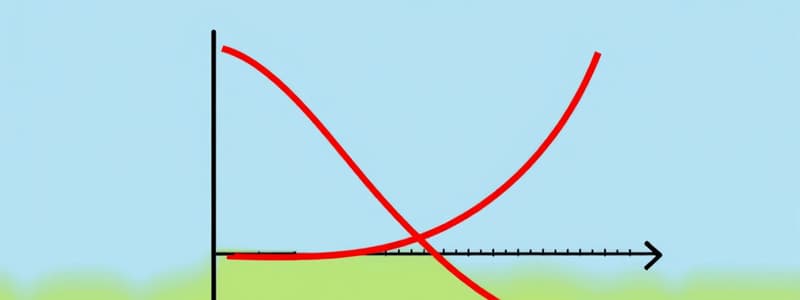Podcast
Questions and Answers
What does the marginal rate of substitution (MRS) signify?
What does the marginal rate of substitution (MRS) signify?
- The overall demand for a good in the market
- The rate at which one good can be substituted for another while maintaining satisfaction (correct)
- The fixed price of two goods
- The total benefits of consuming multiple goods
Indifference curves for perfect substitutes are represented by bowed lines.
Indifference curves for perfect substitutes are represented by bowed lines.
False (B)
What characterizes indifference curves for perfect complements?
What characterizes indifference curves for perfect complements?
Right-angle shapes
The marginal rate of substitution equals the marginal utility of one good divided by the marginal utility of the ______ good.
The marginal rate of substitution equals the marginal utility of one good divided by the marginal utility of the ______ good.
Match the following terms with their definitions:
Match the following terms with their definitions:
What characteristic defines higher indifference curves?
What characteristic defines higher indifference curves?
Indifference curves can intersect without causing inconsistencies in consumer preferences.
Indifference curves can intersect without causing inconsistencies in consumer preferences.
What is the shape of indifference curves in terms of their curvature?
What is the shape of indifference curves in terms of their curvature?
The slope of an indifference curve at any point is known as the __________.
The slope of an indifference curve at any point is known as the __________.
Match the properties of indifference curves with their descriptions:
Match the properties of indifference curves with their descriptions:
Which of the following statements is true about indifference curves?
Which of the following statements is true about indifference curves?
According to the properties of indifference curves, consumers are less willing to trade away goods they have in abundance.
According to the properties of indifference curves, consumers are less willing to trade away goods they have in abundance.
What does the concept of marginal substitution rate reflect in the context of indifference curves?
What does the concept of marginal substitution rate reflect in the context of indifference curves?
What does the budget constraint represent?
What does the budget constraint represent?
An increase in a consumer's income will shift the budget constraint to the left.
An increase in a consumer's income will shift the budget constraint to the left.
What happens to the slope of the budget constraint when income changes but the prices of goods remain the same?
What happens to the slope of the budget constraint when income changes but the prices of goods remain the same?
The slope of the budget constraint measures the rate at which a consumer can trade __________ for another good.
The slope of the budget constraint measures the rate at which a consumer can trade __________ for another good.
Match the following points on a budget constraint with their corresponding descriptions:
Match the following points on a budget constraint with their corresponding descriptions:
What is the main objective of rational consumers when making choices?
What is the main objective of rational consumers when making choices?
Marginal utility increases as more units of a good are consumed.
Marginal utility increases as more units of a good are consumed.
Define marginal utility.
Define marginal utility.
According to the principle of diminishing marginal utility, each additional unit consumed adds _______ to utility than the previous unit.
According to the principle of diminishing marginal utility, each additional unit consumed adds _______ to utility than the previous unit.
Match the following terms with their definitions:
Match the following terms with their definitions:
Which consumption choice reflects the principle of maximization of utility?
Which consumption choice reflects the principle of maximization of utility?
Indifference curves illustrate preferences among different combinations of goods that yield the same satisfaction.
Indifference curves illustrate preferences among different combinations of goods that yield the same satisfaction.
What is the effect of diminishing marginal utility on consumer behavior?
What is the effect of diminishing marginal utility on consumer behavior?
In an indifference curve, a consumer is _____ with combinations that provide the same satisfaction level.
In an indifference curve, a consumer is _____ with combinations that provide the same satisfaction level.
What happens to total utility as a consumer continues to consume more units of a good?
What happens to total utility as a consumer continues to consume more units of a good?
All goods generate the same level of utility regardless of consumption amounts.
All goods generate the same level of utility regardless of consumption amounts.
How does marginal analysis help consumers?
How does marginal analysis help consumers?
According to consumer choice theory, consumers spend their income on goods and services to _______ their total utility.
According to consumer choice theory, consumers spend their income on goods and services to _______ their total utility.
Match the following scenarios with the concepts they illustrate:
Match the following scenarios with the concepts they illustrate:
What happens to the budget constraint when income increases?
What happens to the budget constraint when income increases?
A decrease in the price of goods will not affect the budget constraint.
A decrease in the price of goods will not affect the budget constraint.
What is the effect of a price decrease on the consumption of goods?
What is the effect of a price decrease on the consumption of goods?
An outward rotation of the budget constraint occurs when the price of a good _____ .
An outward rotation of the budget constraint occurs when the price of a good _____ .
Match the terms with their descriptions:
Match the terms with their descriptions:
Which of the following statements describes the impact of a price change on the consumption of cola?
Which of the following statements describes the impact of a price change on the consumption of cola?
The optimum consumption point remains the same when income levels change.
The optimum consumption point remains the same when income levels change.
What is the relationship between income increase and the choices available to a consumer?
What is the relationship between income increase and the choices available to a consumer?
Study Notes
How Rational Consumers Make Choices
- Consumers make choices by maximizing their utility, which is the satisfaction they get from consuming goods and services.
- Consumers spend all of their income on goods and services to maximize utility, ignoring future consumption.
- Marginal utility is the change in utility from consuming one additional unit of a good.
- The principle of diminishing marginal utility states that each additional unit of a good adds less to utility than the previous unit.
- This means that the more of a good we consume, the less satisfaction we get from each additional unit.
Preference and Indifference Curves
- An indifference curve represents all the combinations of goods that give a consumer the same level of satisfaction, meaning the consumer is equally happy with any combination on the curve.
- Higher indifference curves represent higher levels of satisfaction because they imply higher quantities of goods.
- Indifference curves are downward sloping because consumers are willing to give up one good only if they get more of the other good to maintain the same level of satisfaction.
- Indifference curves do not intersect because this would imply that a consumer is equally satisfied with two bundles that have different quantities of goods, which is not possible.
- Indifference curves are convex to the origin (bowed inwards) because consumers are more willing to trade away goods they have in abundance and less willing to trade away goods they have little of.
The Marginal Rate of Substitution
- The slope of an indifference curve at any point represents the marginal rate of substitution (MRS).
- The MRS is the rate at which a consumer is willing to trade one good for another while maintaining the same level of satisfaction.
- The MRS equals the marginal utility of one good divided by the marginal utility of the other good.
Budget Constraint
- The budget constraint shows the limit on the consumption bundles a consumer can afford, given their income and the prices of the goods.
- The slope of the budget constraint represents the relative price of the two goods, which is the price of one good compared to the price of the other.
- A change in income shifts the budget constraint. An increase in income shifts it outwards, allowing the consumer to afford more of both goods.
- A change in the price of one good rotates the budget constraint. A decrease in the price of a good rotates the budget constraint outwards, allowing the consumer to afford more of that good.
Optimal Consumption Bundle
- Consumers choose the combination of goods (consumption bundle) that maximizes their utility given their budget constraint.
- This is achieved where the indifference curve is tangent to the budget constraint.
- At this point, the slope of the indifference curve (MRS) equals the slope of the budget constraint (relative price), indicating that the consumer is getting the most satisfaction possible for their budget.
Studying That Suits You
Use AI to generate personalized quizzes and flashcards to suit your learning preferences.
Related Documents
Description
This quiz explores how rational consumers make choices to maximize utility from goods and services. It covers concepts like marginal utility, diminishing marginal utility, and indifference curves that represent consumer preferences. Test your understanding of these fundamental economic principles.




